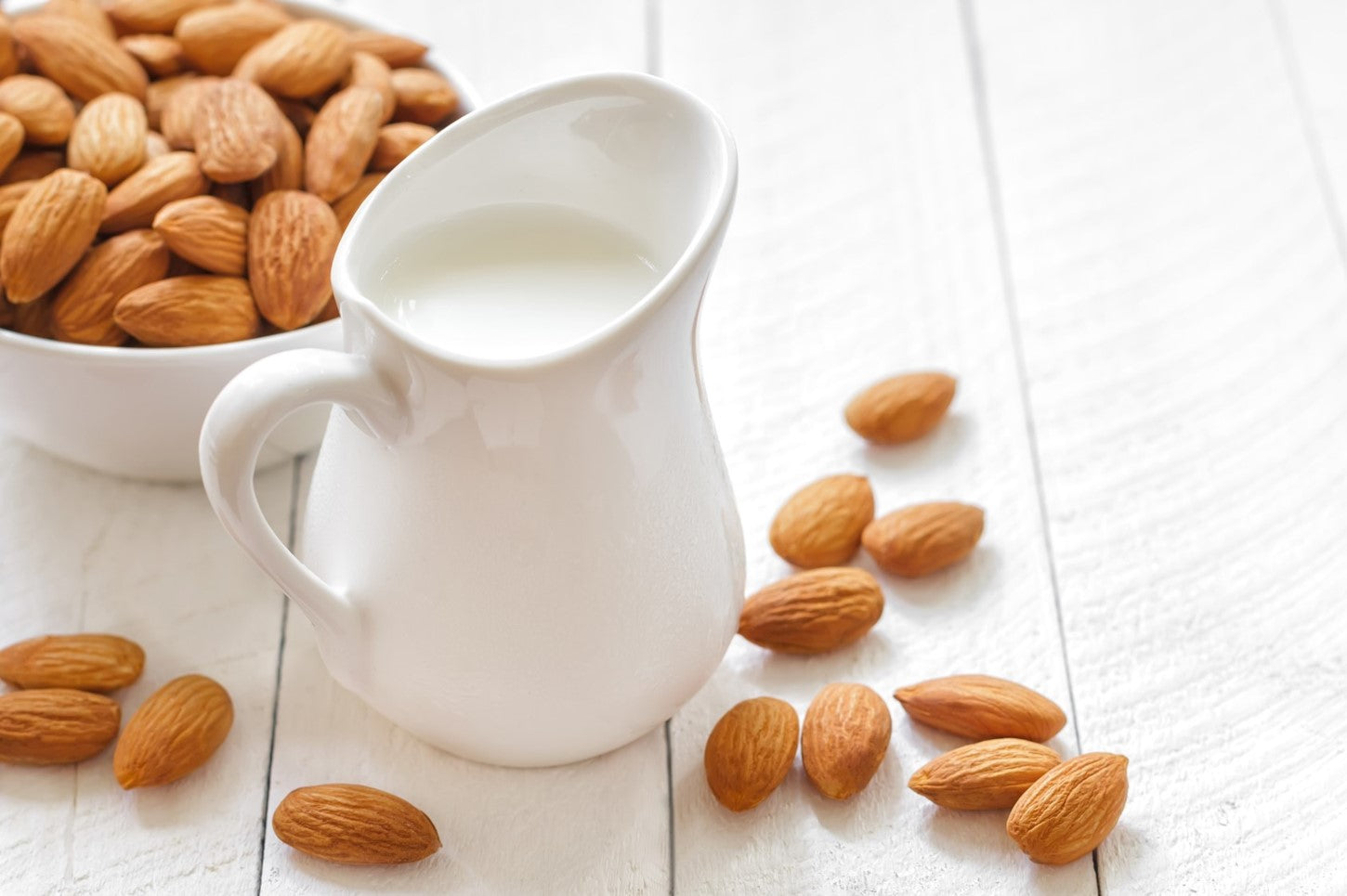
Dr. Eric Venn-Watson’s Highlights
- If you can tolerate dairy, whole milk may be a better choice, as it has healthy fats, calcium, and vitamin C, although it also comes with a certain amount of unhealthy fats.
- Almond milk is better for those with dairy or lactose intolerances, and with fortified options, you can get the fats and protein that you need.
- However, neither milk will give you your full daily dose of C15:0, which you can get through fatty15.
If you grew up as a kid in the 1980s or 1990s, your refrigerator probably included a gallon jug of skim milk. In fact, if you were born after 1980, you may have rarely (or never) had a sip of whole fat milk. Due to dietary guideline changes adopted in the late 1970s, whole fat milk practically went into exile.
Here’s why. In 1977, the U.S. federal government issued health guidelines for more than 220 million Americans, advising everyone to avoid dietary fats in order to keep healthy and avoid heart disease. This was not necessarily surprising, since cardiovascular disease was the leading cause of death in the 1950s, and it was strongly believed by researchers that dietary fats were the primary cause of heart disease
Surprisingly, a 2015 study found that there was never enough evidence to support a complete ban on fat in our diets in the first place. While it was assumed at the time that all fat was bad, we now know that’s not the case.
What Happened to Milk?
The 1977 nutritional guidelines vilified butter and full fat milk, which is why so many 80s and 90s kids grew up on vegetable oil-based margarine and skim milk. Skim milk is milk that has fat extracted from it. A normal, 8 ounce serving of skim milk contains no fat, whereas whole milk contains 8 grams of milkfat.
Since we now know that not all fat is bad, let’s talk about fat contained in milk.
Milk fat is a really complex fat. In fact, it contains over 400 fatty acids. About 70% of the fat contained in whole milk is saturated fat. If that makes you raise your eyebrows, we understand. We’ve been avoiding saturated fat in particular for decades.
The remainder of milk fat is made up of about 3% polyunsaturated fat, and 28% monounsaturated fat. It’s the saturated fat content of whole milk that usually causes us to steer clear.
However, it ends up that not all saturated fats are bad. In fact, some saturated fats are associated with positive health benefits. It all comes down to the type of saturated fat you consume.
Are All Saturated Fats Bad?
We’ve been taught that all saturated fats are bad for us, but mounting research says this isn’t true.† Only some saturated fats are linked with poor health. These saturated fats, called even- chain saturated fats (like C16:0), have been associated with increased inflammation, heart disease, and type 2 diabetes.
On the other hand, odd-chain saturated fatty acids, especially C15:0 (also called pentadecanoic acid), have been repeatedly associated with positive health benefits like balanced immunity, heart health, healthy metabolism, red blood cell health, and liver health.*†
The problem is, whole fat milk contains much higher levels of “bad” even-chain saturated fats and only trace levels of good odd-chain saturated fatty acids, which may not make whole fat milk the best option if you are wanting to get just the good stuff.
What About Almond Milk?
While children of the 80s and 90s were raised on skim milk, children of the 2000s have been raised on “alternative” milks.
Soy milk has been an option for people with milk allergies or lactose intolerance since the 1980s. Some perceived health risks associated with soy, however, may have kept people from using it. Almond milk became popular in the early 2000s as an alternative to using soy, and despite its non-milk-like taste, it has grown in popularity and use alongside increased vegan diets.
Almond milk contains mostly monounsaturated and polyunsaturated fats, which makes it extremely popular as a “healthy” milk alternative choice. An eight ounce serving of almond milk usually contains between three to four grams of fat, compared to the eight grams contained in milk.
While almond milk can be a great option for non-dairy drinkers, it doesn’t have as much protein as whole milk, and doesn’t have nearly the amount of nutrients as cow’s milk unless it has been fortified. Many almond milks are now fortified, however, which brings them closer to par.
Which is Better for Me: Almond Milk or Whole Milk?
Determining which type of milk is actually better for you is pretty subjective. For the average, healthy person who does not have a milk allergy or intolerance, whole milk may be a better option.
Drinking whole milk in moderation could allow a person to get some healthy fat in their diet and fortify their bones with calcium and vitamin D. However, it should be noted that people may not want to drink the amount of whole milk needed every day in order to get enough healthy C15:0 odd-chain saturated fatty acids. Plus, with every glass of milk you down, you also get a serving of even-chain saturated fats, which you may be looking to avoid.
Alternatively, almond milk may be a good choice for people who cannot tolerate dairy or simply follow a vegan diet. In terms of fat and nutrient content, if your almond milk is fortified, it may be a better choice overall simply because it does not contain the even-chain saturated fats that cow’s whole fat milk does. If you drink a lot of milk, almond milk may be the better option. The challenge, however, will be getting that good, odd-chain saturated fat (aka C15:0) into your diet.
Elevate your cells. Elevate your self.
How Can I Get C15:0?
For most types of milks you may choose, you’re likely not going to get your full daily dose of C15:0 (studies support that we need about 100 mg of C15:0 per day to support our general and cellular health).* As such, we need to find a better way to get this healthy fat into our bodies, and there’s a simple way to do it.
Fatty15 is a once a day supplement that contains FA15™, a pure powder and vegan-friendly form of C15:0. Science supports that this supplement can give your body the daily amount of healthy C15:0 you need to provide important health benefits:*†
- Cellular health. As we age, our cells become more fragile, which is a primary driver of aging-related degradation. Fatty15 serves as armor for our cell membranes and supports overall cellular health, enabling our cells to function well and live longer.
- Immunity support. Fatty15 promotes healthy immune function by naturally binding to key receptors found throughout our bodies that keep our immunity balanced.
- Healthy metabolism. Proper regulation of our metabolism slows with age. Fatty15 can better regulate your metabolism and help you maintain healthy cholesterol and glucose levels.
- Heart health. Studies support that Fatty15 can support healthy cholesterol levels and may support your overall heart health.
- Aging on your own terms. Our physical age is defined by eight hallmarks of aging, and C15:0 targets three of them. We can give our aging cells a fighting chance by giving them C15:0 which science supports can promote overall cellular health, which in turns helps us age on our own terms.
~
Both dairy milk and almond milk can be good choices for your overall health depending on your lifestyle, dietary needs, and restrictions. Most types of milk, however, won’t provide you with the amount of C15:0 that science now supports your cells need to stay healthy and resilient.*† Adding fatty15 to your health stack can give you the ability to stay healthy and doing the things you love.*†
Sources:
https://openheart.bmj.com/content/2/1/e000196
https://www.ncbi.nlm.nih.gov/pmc/articles/PMC2596709/

Eric Venn-Watson M.D.
CEO, Co-Founder
Senior Scientist, Co-Founder
Eric is a physician, U.S. Navy veteran, and Co-founder and COO of Seraphina Therapeutics. Eric served over 25 years as a Navy and Marine Corps physician, working with the special forces community to improve their health and fitness. Seraphina Therapeutics is a health and wellness company dedicated to advancing global health through the discovery of essential fatty acids and micronutrient therapeutics.
You May Also Like...
10 Foods Good for Your Liver: The Ultimate Guide
Your liver does a lot for you. If it had a voice of its own, it might ask you to eat more veggies and cut back on your Old Fashioneds. Unfortunately, the liver doesn’t receive a lot of attention until...
How To Improve Your Gut Microbiome: 6 Tips
Interested in how to improve your gut microbiome? We’ve got six tips to help your gut thrive and improve your overall digestion.


